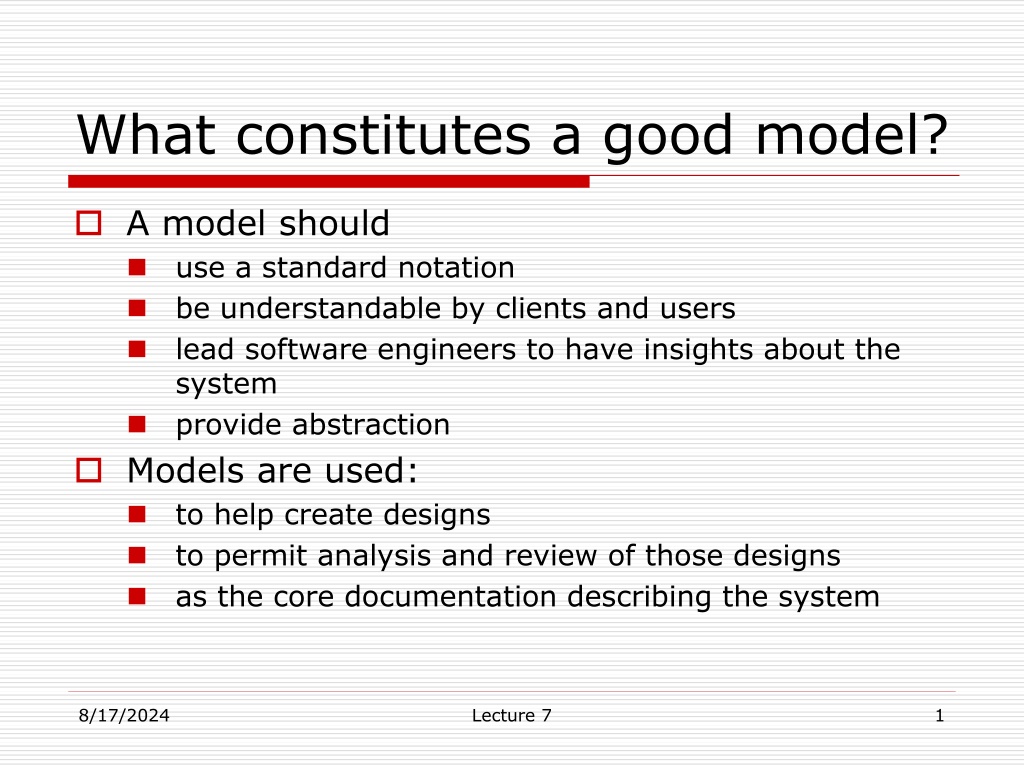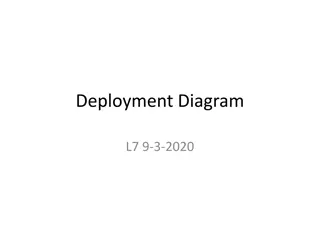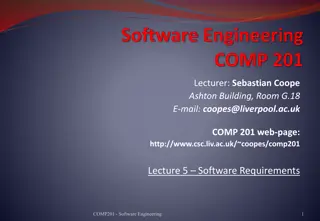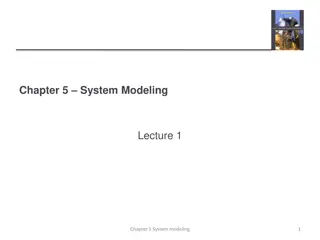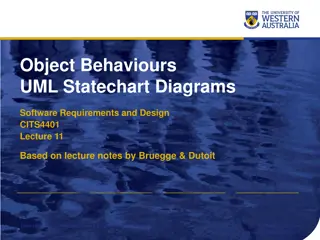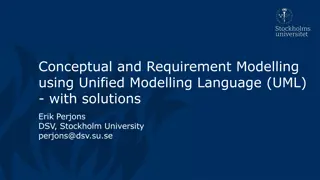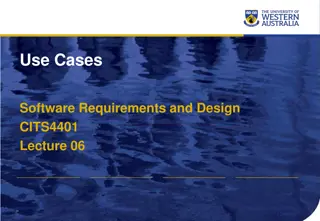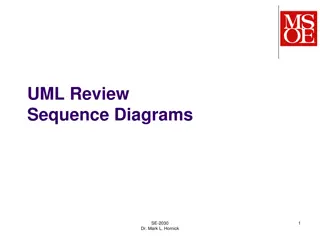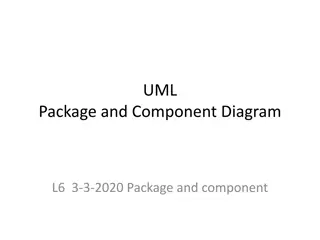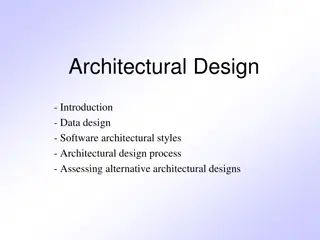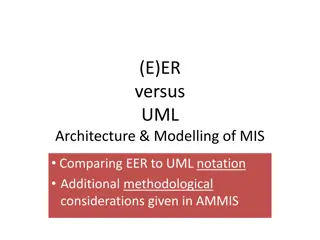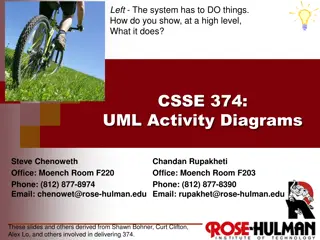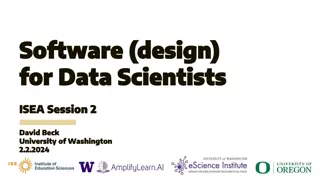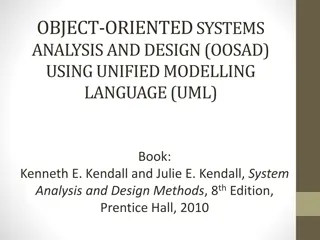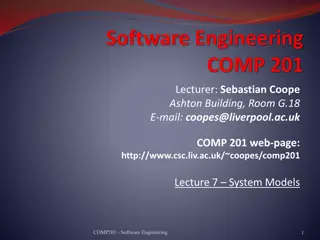Understanding UML for Effective Software Design
A good model should utilize standard notation, be easily understandable, and provide insights for software engineers. UML features, essentials of UML class diagrams, and details on classes, associations, and multiplicity are covered. The objective is to assist in software development through abstraction and design documentation. Analyzing and validating associations are discussed with practical examples to clarify the nature of relationships between classes.
Download Presentation

Please find below an Image/Link to download the presentation.
The content on the website is provided AS IS for your information and personal use only. It may not be sold, licensed, or shared on other websites without obtaining consent from the author. Download presentation by click this link. If you encounter any issues during the download, it is possible that the publisher has removed the file from their server.
E N D
Presentation Transcript
What constitutes a good model? A model should use a standard notation be understandable by clients and users lead software engineers to have insights about the system provide abstraction Models are used: to help create designs to permit analysis and review of those designs as the core documentation describing the system 8/17/2024 Lecture 7 1
UML features It has detailed semantics It has extension mechanisms It has an associated textual language Object Constraint Language (OCL) The objective of UML is to assist in software development It is not a methodology 8/17/2024 Lecture 7 2
Essentials of UML Class Diagrams The main symbols shown on class diagrams are: Classes represent the types of data themselves Associations represent linkages between instances of classes Attributes are simple data found in classes and their instances Operations represent the functions performed by the classes and their instances Generalizations group classes into inheritance hierarchies 8/17/2024 Lecture 7 3
Classes A class is simply represented as a box with the name of the class inside The diagram may also show the attributes and operations The complete signature of an operation is: operationName(parameterName: parameterType ): returnType 8/17/2024 Lecture 7 4
Associations and Multiplicity An association is used to show how two classes are related to each other Symbols indicating multiplicity are shown at each end of the association 8/17/2024 Lecture 7 5
Labelling associations Each association can be labelled, to make explicit the nature of the association 8/17/2024 Lecture 7 6
Analyzing and validating associations Many-to-one A company has many employees, An employee can only work for one company. This company will not store data about the moonlighting activities of employees! A company can have zero employees E.g. a shell company It is not possible to be an employee unless you work for a company worksFor 1 Employee Company * 8/17/2024 Lecture 7 7
Analyzing and validating associations Many-to-many An assistant can work for many managers A manager can have many assistants Assistants can work in pools Managers can have a group of assistants Some managers might have zero assistants. Is it possible for an assistant to have, perhaps temporarily, zero managers? * 1..* * * * * * Manager Assistant supervisor 8/17/2024 Lecture 7 8
Analyzing and validating associations One-to-one For each company, there is exactly one board of directors A board is the board of only one company A company must always have a board A board must always be of some company 1 1 Company BoardOfDirectors 8/17/2024 Lecture 7 9
Analyzing and validating associations Avoid unnecessary one-to-one associations Avoid this do this 8/17/2024 Lecture 7 10
A more complex example A booking is always for exactly one passenger no booking with zero passengers a booking could never involve more than one passenger A Passenger can have any number of Bookings a passenger could have no bookings at all a passenger could have more than one booking The frame around this diagram is an optional feature that any UML 2.0 may possess 8/17/2024 Lecture 7 11
Association classes Sometimes, an attribute that concerns two associated classes cannot be placed in either of the classes The following are equivalent 8/17/2024 Lecture 7 12
Reflexive associations It is possible for an association to connect a class to itself 8/17/2024 Lecture 7 13
Directionality in associations Associations are by default bi-directional It is possible to limit the direction of an association by adding an arrow at one end 8/17/2024 Lecture 7 14
Generalization Specializing a superclass into two or more subclasses A generalization set is a labelled group of generalizations with a common superclass The label (sometimes called the discriminator) describes the criteria used in the specialization 8/17/2024 Lecture 7 15
More Advanced Features: Aggregation Aggregations are special associations that represent part-whole relationships. The whole side is often called the assembly or the aggregate This symbol is a shorthand notation association named isPartOf 8/17/2024 Lecture 7 16
When to use an aggregation As a general rule, you can mark an association as an aggregation if the following are true: You can state that the parts are part of the aggregate or the aggregate is composed of the parts When something owns or controls the aggregate, then they also own or control the parts 8/17/2024 Lecture 7 17
Composition A composition is a strong kind of aggregation if the aggregate is destroyed, then the parts are destroyed as well Two alternatives for addresses 8/17/2024 Lecture 7 18
Aggregation hierarchy 8/17/2024 Lecture 7 19
The Process of Developing Class Diagrams You can create models at different stages and with different purposes and levels of details Exploratory domain model: Developed in domain analysis to learn about the domain System domain model: Models aspects of the domain represented by the system System model: Includes also classes used to build the user interface and system architecture 8/17/2024 Lecture 7 20
System domain model vs System model 8/17/2024 Lecture 7 21
System domain model vs System model The system domain model omits many classes that are needed to build a complete system Can contain less than half the classes of the system Should be developed to be used independently of particular sets of user interface classes architectural classes The complete system model includes The system domain model User interface classes Architectural classes Utility classes 8/17/2024 Lecture 7 22
Suggested sequence of activities Identify a first set of candidate classes Add associations and attributes Find generalizations List the main responsibilities of each class Decide on specific operations Iterate over the entire process until the model is satisfactory Add or delete classes, associations, attributes, generalizations, responsibilities or operations Identify interfaces Apply design patterns Don t be too disorganized. Don t be too rigid 8/17/2024 either. Lecture 7 23
Identifying classes When developing a domain model you tend to discover classes When you work on the user interface or the system architecture, you tend to invent classes Needed to solve a particular design problem (Inventing may also occur when creating a domain model) Reuse should always be a concern Frameworks System extensions Similar systems 8/17/2024 Lecture 7 24
A simple technique for discovering domain classes Look at a source material such as a description of requirements Extract the nouns and noun phrases Eliminate nouns that: are redundant represent instances are vague or highly general not needed in the application Pay attention to classes in a domain model that represent types of users or other actors 8/17/2024 Lecture 7 25
Airline Reservation System Ootumlia Airlines run sightseeing flights from Java Valley, the capital of Ootumlia. The reservation system keeps track of passengers who will be flying in specific seats on various flights, as well as people who will form the crew. For the crew, the system needs to track what everyone does, and who supervises whom. Ootumlia Airlines expects to expand in the future so the system needs to be flexible; in particular, it will be adding a frequent-flier plan. 8/17/2024 Lecture 7 26
Identifying associations and attributes Start with classes you think are most central and important Decide on the clear and obvious data it must contain and its relationships to other classes. Work outwards towards the classes that are less important. Avoid adding many associations and attributes to a class A system is simpler if it manipulates less information 8/17/2024 Lecture 7 27
Tips about identifying and specifying valid associations An association should exist if a class possesses controls is connected to is related to is a part of has as parts is a member of, or has as members some other class in your model Specify the multiplicity at both ends Label it clearly 8/17/2024 Lecture 7 28
Actions versus associations A common mistake is to represent actions as if they were associations Better: The borrowoperation creates a Loan, and the returnoperation sets the returnedDate attribute. Bad, due to the use of associations that are actions 8/17/2024 Lecture 7 29
Identifying attributes Look for information that must be maintained about each class Several nouns rejected as classes, may now become attributes An attribute should generally contain a simple value E.g. string, number 8/17/2024 Lecture 7 30
Tips about identifying and specifying valid attributes It is not good to have many duplicate attributes If a subset of a class s attributes form a coherent group, then create a distinct class containing these attributes 8/17/2024 Lecture 7 31
An associations) example (attributes and 8/17/2024 Lecture 7 32
Identifying interfaces generalizations and There are two ways to identify generalizations: bottom-up Group together similar superclass top-down Look for more general classes first, specialize them if needed Create an interface, instead of a superclass if The classes are very dissimilar except for having a few operations in common One or more of the classes already have their own superclasses Different implementations of the same class might be available classes creating a new 8/17/2024 Lecture 7 33
An example (generalization) 8/17/2024 Lecture 7 34
Allocating responsibilities to classes A responsibility is something that the system is required to do Each functional requirement must be attributed to one of the classes All the responsibilities of a given class should be clearly related. If a class has too many responsibilities, consider splitting it into distinct classes If a class has no responsibilities attached to it, then it is probably useless When a responsibility cannot be attributed to any of the existing classes, then a new class should be created To determine responsibilities Perform use case analysis Look for verbs and nouns describing actions in the system description 8/17/2024 Lecture 7 35
Categories of responsibilities Setting and getting the values of attributes Creating and initializing new instances Loading to and saving from persistent storage Destroying instances Adding and deleting links of associations Copying, converting, transforming, transmitting or outputting Computing numerical results Navigating and searching Other specialized work 8/17/2024 Lecture 7 36
An example (responsibilities) Creating a new regular flight Searching for a flight Modifying attributes of a flight Creating a specific flight Booking a passenger Canceling a booking 8/17/2024 Lecture 7 37
Prototyping a class diagram on paper As you identify classes, you write their names on small cards As you identify attributes and responsibilities, you list them on the cards If you cannot fit all the responsibilities on one card: this suggests you should split the class into two related classes Move the cards around on a whiteboard to arrange them into a class diagram Draw lines among the cards to represent associations and generalizations 8/17/2024 Lecture 7 38
Identifying operations Operations responsibilities of each class There may be several operations per responsibility The main operations that implement a responsibility are normally declared public Other methods that collaborate to perform the responsibility must be as private as possible are needed to realize the 8/17/2024 Lecture 7 39
An example (class collaboration) 8/17/2024 Lecture 7 40
Class collaboration a 0..1 SpecificFlight * Airplane Making a bi-directional link between two existing objects; e.g. adding a link between an instance of SpecificFlight and an instance of Airplane. 1. (public) The instance of SpecificFlight makes a one-directional link to the instance of Airplane then calls operation 2. 2. (non-public) The instance of Airplane makes a one-directional link back to the instance of SpecificFlight 8/17/2024 Lecture 7 41
SpecificFlight FlightLog 0..1 0..1 0..1 0..1 0..1 0..1 1 Class collaboration b + createFlightLog [b1] FlightLog [b2] Creating an object and linking it to an existing object e.g. creating a FlightLog, and linking it to a SpecificFlight. 1. (public) The instance of SpecificFlight calls the constructor of FlightLog (operation 2) then makes a one-directional link to the new instance of FlightLog. 2. (non-public) Class FlightLog s constructor makes a one-directional link back to the instance of SpecificFlight. 8/17/2024 Lecture 7 42
PassengerRole Booking SpecificFlight 1 * * * * * * 1 + makeBooking [c1] addLinkToBooking [c4] * Booking [c2] addLinkToBooking [c3] Class collaboration c Creating an association class, given two existing objects e.g. creating an instance of Booking, which will link a SpecificFlight to a PassengerRole 1. (public) The instance of PassengerRole calls the constructor of Booking (operation 2). 2. (non-public) Class Booking s constructor, among its other actions makes a one-directional link back to the instance of PassengerRole makes a one-directional link to the instance of SpecificFlight calls operations 3 and 4 3. (non-public) The instance of SpecificFlight makes a one-directional link to the instance of Booking 4. (non-public) The instance of PassengerRole makes a one-directional link to the instance of Booking 8/17/2024 Lecture 7 43
Airplane 0..1 SpecificFlight * addLinkToSpecificFlight [a2, d3] deleteLinkToSpecificFlight [d2] + changeAirplane [d1] Class collaboration d Changing the destination of a link e.g. changing the Airplane of to a SpecificFlight, from airplane1 to airplane2 1. (public) The instance of SpecificFlight deletes the link to airplane1 makes a one-directional link to airplane2 calls operation 2 then calls operation 3. 2. (non-public) airplane1 deletes its one-directional link to the instance of SpecificFlight. 3. (non-public) airplane2 makes a one-directional link to the instance of SpecificFlight. 8/17/2024 Lecture 7 44
EmployeeRole SpecificFlight * crewMember * + getName [e2] + findCrewMember [e1] Class collaboration e Searching for an associated instance e.g. searching for a crew member associated with a SpecificFlight that has a certain name 1. (public) The instance of SpecificFlight creates an Iterator over all the crewMember links of the SpecificFlight for each of them call operation 2, until it finds a match 2. (may be public) The instance of EmployeeRole returns its name 8/17/2024 Lecture 7 45
Implementing Class Diagrams in Java Attributes are implemented as instance variables Generalizations are implemented using extends Interfaces are implemented using implements Associations are normally implemented using instance variables Divide each two-way association into two one-way associations so each associated class has an instance variable. For a one-way association where the multiplicity at the other end is one or optional declare a variable of that class (a reference) For a one-way association where the multiplicity at the other end is many : use a collection class implementing List, such as Vector 8/17/2024 Lecture 7 46
Example: SpecificFlight class SpecificFlight { private Calendar date; private RegularFlight regularFlight; ... // Constructor that should only be called from // addSpecificFlight SpecificFlight( Calendar aDate, RegularFlight aRegularFlight) { date = aDate; regularFlight = aRegularFlight; } } 8/17/2024 Lecture 7 47
Example: RegularFlight class RegularFlight { private List specificFlights; ... // Method that has primary responsibility public void addSpecificFlight(Calendar aDate) { SpecificFlight newSpecificFlight; newSpecificFlight = new SpecificFlight(aDate, this); specificFlights.add(newSpecificFlight); } ... } 8/17/2024 Lecture 7 48
